Material Symmetries in Homogenized Hexagonal-Shaped Composites as Cosserat Continua
Abstract
1. Introduction
2. Framework of Cosserat Theory
3. Finite Element Implementation
4. Numerical Applications
- ,
- ,
- ,
- ,
- ,
- The upper-right area has and where any combination is theoretically possible in the given domain range. In this area, regular hexagons are present as well as diamond shaped ones (according to Figure 3).
- The lower-left area has and where not all shapes are achievable due to some self-intersections of hexagons. In this area, hourglass shaped hexagons are present (symmetric and not-symmetric ones) according to Figure 3.
- The upper-left and lower-right areas have and and and , respectively. These shapes might be characterized by an asymmetric shape (according to Figure 3).
- rectangular:
- hourglass:
- diamond:
- regular:
- skew:
- tip: ,
5. Conclusions
Author Contributions
Funding
Conflicts of Interest
References
- Baraldi, D.; Reccia, E.; Cecchi, A. In plane loaded masonry walls: DEM and FEM/DEM models. A critical review. Meccanica 2018, 53, 1613–1628. [Google Scholar] [CrossRef]
- Reccia, E.; Leonetti, L.; Trovalusci, P.; Cecchi, A. A multiscale/multidomain model for the failure analysis of masonry walls: A validation with a combined FEM/DEM approach. Int. J. Multiscale Comp. Eng. 2018, 16, 325–343. [Google Scholar] [CrossRef]
- Ehlers, W.; Ramm, E.; Diebels, S.; D’Addetta, G. From particle ensembles to Cosserat continua: Homogenization of contact forces towards stresses and couple stresses. Int. J. Solids Struct. 2003, 40, 6681–6702. [Google Scholar] [CrossRef]
- Bigoni, D.; Drugan, W.J. Analytical derivation of Cosserat moduli via homogenization of heterogeneous elastic materials. J. Appl. Mech. 2006, 74, 741–753. [Google Scholar] [CrossRef]
- Li, X.; Liu, Q.; Zhang, J. A micro–macro homogenization approach for discrete particle assembly—Cosserat continuum modeling of granular materials. Int. J. Solids Struct. 2010, 47, 291–303. [Google Scholar] [CrossRef]
- Reasa, D.R.; Lakes, R.S. Cosserat effects in achiral and chiral cubic lattices. J. Appl. Mech. 2019, 86, 111009. [Google Scholar] [CrossRef]
- Trovalusci, P. Molecular Approaches for Multifield Continua: Origins and current developments. In Multiscale Modeling of Complex Materials: Phenomenological, Theoretical and Computational Aspects; Sadowski, T., Trovalusci, P., Eds.; Springer: Vienna, Austria, 2014; pp. 211–278. [Google Scholar]
- Tuna, M.; Kirca, M.; Trovalusci, P. Deformation of atomic models and their equivalent continuum counterparts using Eringen’s two-phase local/nonlocal model. Mech. Res. Commun. 2019, 97, 26–32. [Google Scholar] [CrossRef]
- Tuna, M.; Trovalusci, P. Scale dependent continuum approaches for discontinuous assemblies: ‘Explicit’ and ‘implicit’ non-local models. Mech. Res. Commun. 2020, 103, 103461. [Google Scholar] [CrossRef]
- Larsson, R.; Zhang, Y. Homogenization of microsystem interconnects based on micropolar theory and discontinuous kinematics. J. Mech. Phys. Solids 2007, 55, 819–841. [Google Scholar] [CrossRef]
- Alibert, J.J.; Della Corte, A. Second-gradient continua as homogenized limit of pantographic microstructured plates: A rigorous proof. Z. Für Angew. Math. Und Phys. 2015, 66, 2855–2870. [Google Scholar] [CrossRef]
- Demir, C.; Civalek, O. On the analysis of microbeams. Int. J. Eng. Sci. 2017, 121, 14–33. [Google Scholar] [CrossRef]
- Civalek, O.; Demir, C. A simple mathematical model of microtubules surrounded by an elastic matrix by nonlocal finite element method. Appl. Math. Comput. 2016, 289, 335–352. [Google Scholar] [CrossRef]
- Sluys, L.; de Borst, R.; Muhlhaus, H.B. Wave propagation, localization and dispersion in a gradient-dependent medium. Int. J. Solids Struct. 1993, 30, 1153–1171. [Google Scholar] [CrossRef]
- Kouznetsova, V.; Geers, M.G.D.; Brekelmans, W.A.M. Multi-scale constitutive modelling of heterogeneous materials with a gradient-enhanced computational homogenization scheme. Int. J. Numer. Methods Eng. 2002, 54, 1235–1260. [Google Scholar] [CrossRef]
- Kouznetsova, V.; Geers, M.; Brekelmans, W. Multi-scale second-order computational homogenization of multi-phase materials: A nested finite element solution strategy. Comput. Methods Appl. Mech. Eng. 2004, 193, 5525–5550. [Google Scholar] [CrossRef]
- Massart, T.J.; Peerlings, R.H.J.; Geers, M.G.D. An enhanced multi-scale approach for masonry wall computations with localization of damage. Int. J. Numer. Methods Eng. 2007, 69, 1022–1059. [Google Scholar] [CrossRef]
- Capecchi, D.; Ruta, G.; Trovalusci, P. Voigt and Poincaré’s mechanistic–energetic approaches to linear elasticity and suggestions for multiscale modelling. Arch. Appl. Mech. 2011, 81, 1573–1584. [Google Scholar] [CrossRef]
- Leismann, T.; Mahnken, R. Comparison of hyperelastic micromorphic, micropolar and microstrain continua. Int. J. Non-Linear Mech. 2015, 77, 115–127. [Google Scholar] [CrossRef]
- Peerlings, R.H.J.; Fleck, N.A. Computational evaluation of strain gradient elasticity constants. Int. J. Multiscale Comput. Eng. 2004, 2. [Google Scholar] [CrossRef]
- Uzun, B.; Civalek, O. Nonlocal FEM formulation for vibration analysis of nanowires on elastic matrix with different materials. Math. Comput. Appl. 2019, 24, 38. [Google Scholar] [CrossRef]
- Drugan, W.; Willis, J. A micromechanics-based nonlocal constitutive equation and estimates of representative volume element size for elastic composites. J. Mech. Phys. Solids 1996, 44, 497–524. [Google Scholar] [CrossRef]
- Luciano, R.; Willis, J. Bounds on non-local effective relations for random composites loaded by configuration-dependent body force. J. Mech. Phys. Solids 2000, 48, 1827–1849. [Google Scholar] [CrossRef]
- Smyshlyaev, V.; Cherednichenko, K. On rigorous derivation of strain gradient effects in the overall behaviour of periodic heterogeneous media. J. Mech. Phys. Solids 2000, 48, 1325–1357. [Google Scholar] [CrossRef]
- Bacca, M.; Bigoni, D.; Corso, F.D.; Veber, D. Mindlin second-gradient elastic properties from dilute two-phase Cauchy-elastic composites. Part I: Closed form expression for the effective higher-order constitutive tensor. Int. J. Solids Struct. 2013, 50, 4010–4019. [Google Scholar] [CrossRef]
- Barretta, R.; Luciano, R.; de Sciarra, F.M. A fully gradient model for Euler-Bernoulli nanobeams. Math. Probl. Eng. 2015, 2015. [Google Scholar] [CrossRef]
- Demir, C.; Civalek, O. A new nonlocal FEM via Hermitian cubic shape functions for thermal vibration of nano beams surrounded by an elastic matrix. Compos. Struct. 2017, 168, 872–884. [Google Scholar] [CrossRef]
- Canadija, M.; Barretta, R.; de Sciarra, F.M. A gradient elasticity model of Bernoulli-Euler nanobeams in non-isothermal environments. Eur. J. Mech. A Solids 2016, 55, 243–255. [Google Scholar] [CrossRef]
- Barretta, R.; de Sciarra, F.M. A nonlocal model for carbon nanotubes under axial loads. Adv. Mater. Sci. Eng. 2013, 2013. [Google Scholar] [CrossRef]
- Barretta, R.; Faghidian, S.A.; Luciano, R. Longitudinal vibrations of nano-rods by stress-driven integral elasticity. Mech. Adv. Mater. Struct. 2019, 26, 1307–1315. [Google Scholar] [CrossRef]
- Masiani, R.; Trovalusci, P. Cosserat and Cauchy materials as continuum models of brick masonry. Meccanica 1996, 31, 421–432. [Google Scholar] [CrossRef]
- Forest, S.; Sab, K. Cosserat overall modeling of heterogeneous materials. Mech. Res. Commun. 1998, 25, 449–454. [Google Scholar] [CrossRef]
- Forest, S.; Dendievel, R.; Canova, G.R. Estimating the overall properties of heterogeneous Cosserat materials. Model. Simul. Mater. Sci. Eng. 1999, 7, 829–840. [Google Scholar] [CrossRef]
- Ostoja-Starzewski, M.; Boccara, S.D.; Jasiuk, I. Couple-stress moduli and characteristics length of a two-phase composite. Mech. Res. Commun. 1999, 26, 387–396. [Google Scholar] [CrossRef]
- Bouyge, F.; Jasiuk, I.; Ostoja-Starzewski, M. A micromechanically based couple–stress model of an elastic two-phase composite. Int. J. Solids Struct. 2001, 38, 1721–1735. [Google Scholar] [CrossRef]
- Forest, S.; Pradel, F.; Sab, K. Asymptotic analysis of heterogeneous Cosserat media. Int. J. Solids Struct. 2001, 38, 4585–4608. [Google Scholar] [CrossRef]
- Onck, P.R. Cosserat modeling of cellular solids. Comptes Rendus MÉcanique 2002, 330, 717–722. [Google Scholar] [CrossRef]
- Trovalusci, P.; Masiani, R. Non-linear micropolar and classical continua for anisotropic discontinuous materials. Int. J. Solids Struct. 2003, 40, 1281–1297. [Google Scholar] [CrossRef]
- Trovalusci, P.; Masiani, R. A multifield model for blocky materials based on multiscale description. Int. J. Solids Struct. 2005, 42, 5778–5794. [Google Scholar] [CrossRef][Green Version]
- Trovalusci, P.; Sansalone, V. A Numerical Investigation of Structure-Property Relations in Fiber Composite Materials. Int. J. Multiscale Comput. Eng. 2007, 5, 141–152. [Google Scholar]
- Tekoglu, C.; Onck, P.R. Size effects in two-dimensional Voronoi foams: A comparison between generalized continua and discrete models. J. Mech. Phys. Solids 2008, 56, 3541–3564. [Google Scholar] [CrossRef]
- Kunin, I.A. The theory of elastic media with microstructure and the theory of dislocations. In Mechanics of Generalized Continua; Kröner, E., Ed.; Springer: Berlin/Heidelberg, Germany, 1968; pp. 321–329. [Google Scholar]
- Trovalusci, P.; Varano, V.; Rega, G. A generalized continuum formulation for composite microcracked materials and wave propagation in a bar. J. Appl. Mech. 2010, 77, 061002. [Google Scholar] [CrossRef]
- Reda, H.; Rahali, Y.; Ganghoffer, J.; Lakiss, H. Wave propagation in 3D viscoelastic auxetic and textile materials by homogenized continuum micropolar models. Compos. Struct. 2016, 141, 328–345. [Google Scholar] [CrossRef]
- Eremeyev, V.A.; Rosi, G.; Naili, S. Transverse surface waves on a cylindrical surface with coating. Int. J. Eng. Sci. 2019, 147, 103188. [Google Scholar] [CrossRef]
- Settimi, V.; Trovalusci, P.; Rega, G. Dynamical properties of a composite microcracked bar based on a generalized continuum formulation. Contin. Mech. Thermodyn. 2019, 31, 1627–1644. [Google Scholar] [CrossRef]
- Trovalusci, P.; Masiani, R. Material symmetries of micropolar continua equivalent to lattices. Int. J. Solids Struct. 1999, 36, 2091–2108. [Google Scholar] [CrossRef]
- Pau, A.; Trovalusci, P. Block masonry as equivalent micropolar continua: The role of relative rotations. Acta Mech. 2012, 223, 1455–1471. [Google Scholar] [CrossRef]
- Trovalusci, P.; Pau, A. Derivation of microstructured continua from lattice systems via principle of virtual works: The case of masonry-like materials as micropolar, second gradient and classical continua. Acta Mech. 2014, 225, 157–177. [Google Scholar] [CrossRef]
- Fantuzzi, N.; Trovalusci, P.; Dharasura, S. Mechanical behavior of anisotropic composite materials as micropolar continua. Front. Mater. 2019, 6, 59. [Google Scholar] [CrossRef]
- Chen, W.; Xu, M.; Li, L. A model of composite laminated Reddy plate based on new modified couple stress theory. Compos. Struct. 2012, 94, 2143–2156. [Google Scholar] [CrossRef]
- Roque, C.; Fidalgo, D.; Ferreira, A.; Reddy, J. A study of a microstructure-dependent composite laminated Timoshenko beam using a modified couple stress theory and a meshless method. Compos. Struct. 2013, 96, 532–537. [Google Scholar] [CrossRef]
- Fantuzzi, N.; Leonetti, L.; Trovalusci, P.; Tornabene, F. Some novel numerical applications of Cosserat continua. Int. J. Comput. Methods 2018, 15, 1850054. [Google Scholar] [CrossRef]
- Trovalusci, P.; Bellis, M.L.D.; Masiani, R. A multiscale description of particle composites: From lattice microstructures to micropolar continua. Compos. Part B Eng. 2017, 128, 164–173. [Google Scholar] [CrossRef]
- Rizzi, G.; Corso, F.D.; Veber, D.; Bigoni, D. Identification of second-gradient elastic materials from planar hexagonal lattices. Part II: Mechanical characteristics and model validation. Int. J. Solids Struct. 2019, 176–177, 19–35. [Google Scholar] [CrossRef]
- Eremeyev, V.A.; Pietraszkiewicz, W. Material symmetry group and constitutive equations of micropolar anisotropic elastic solids. Math. Mech. Solids 2016, 21, 210–221. [Google Scholar] [CrossRef]
- Aguiar, A.R.; Lopes da Rocha, G. On the number of invariants in the strain energy density of an anisotropic nonlinear elastic material with Two Material Symmetry Directions. J. Elast. 2018, 131, 125–132. [Google Scholar] [CrossRef]
- Scherphuis, J. Jaap’s Puzzle Page. 2019. Available online: http://www.jaapsch.net/tilings (accessed on 19 September 2019).
- Sokolowski, M. Theory of Couple–Stresses in Bodies with Constrained Rotations; CISM Courses and Lectures; Springer: Vienna, Austria, 1972. [Google Scholar]
- Fantuzzi, N.; Trovalusci, P.; Luciano, R. Multiscale analysis of anisotropic materials with hexagonal microstructure as micro-polar continua. Int. J. Multiscale Comput. Eng. 2020, 1, 1–20. [Google Scholar]
- Leonetti, L.; Fantuzzi, N.; Trovalusci, P.; Tornabene, F. Scale effects in orthotropic composite assemblies as micropolar continua: A comparison between weak- and strong-form finite element solutions. Materials 2019, 12, 758. [Google Scholar] [CrossRef]
- Ferreira, A. MATLAB Codes for Finite Element Analysis: Solids and Structures. In Solid Mechanics and Its Applications; Springer: Amsterdam, The Netherlands, 2008. [Google Scholar]
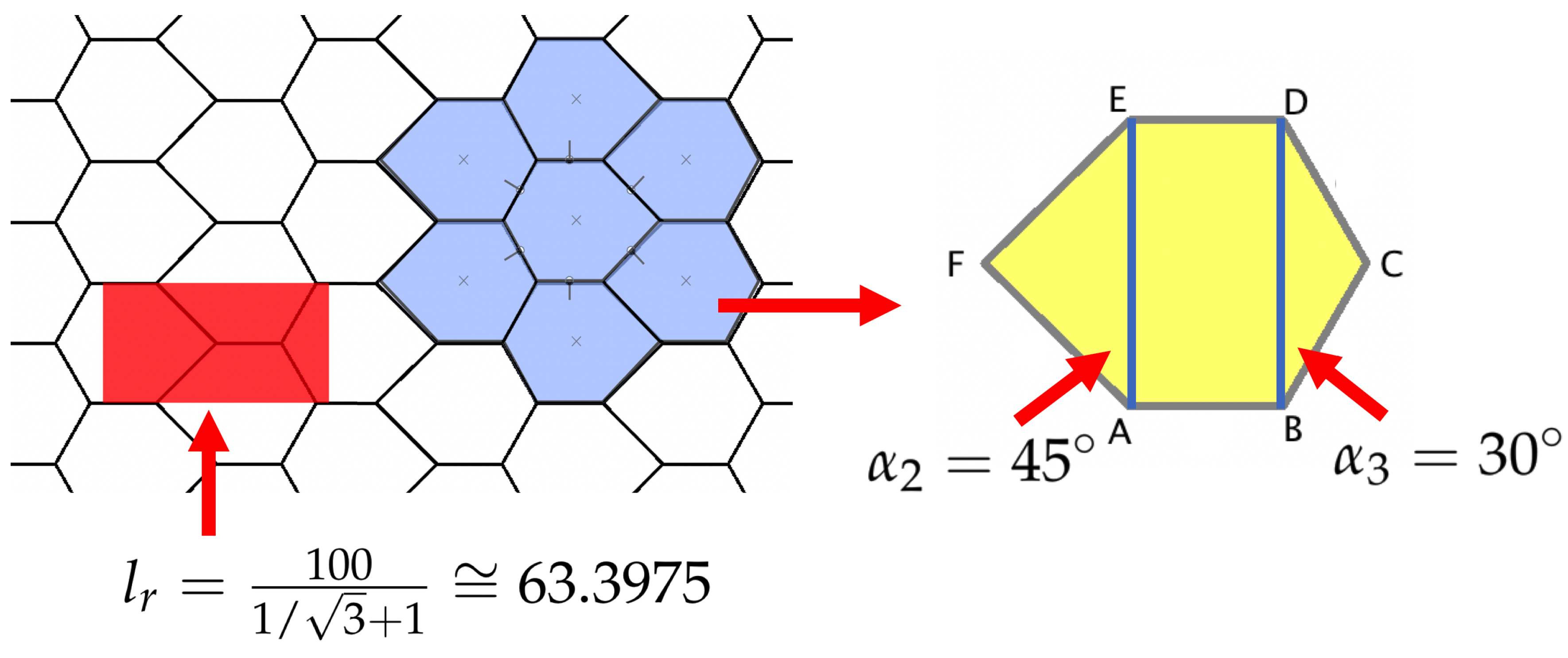
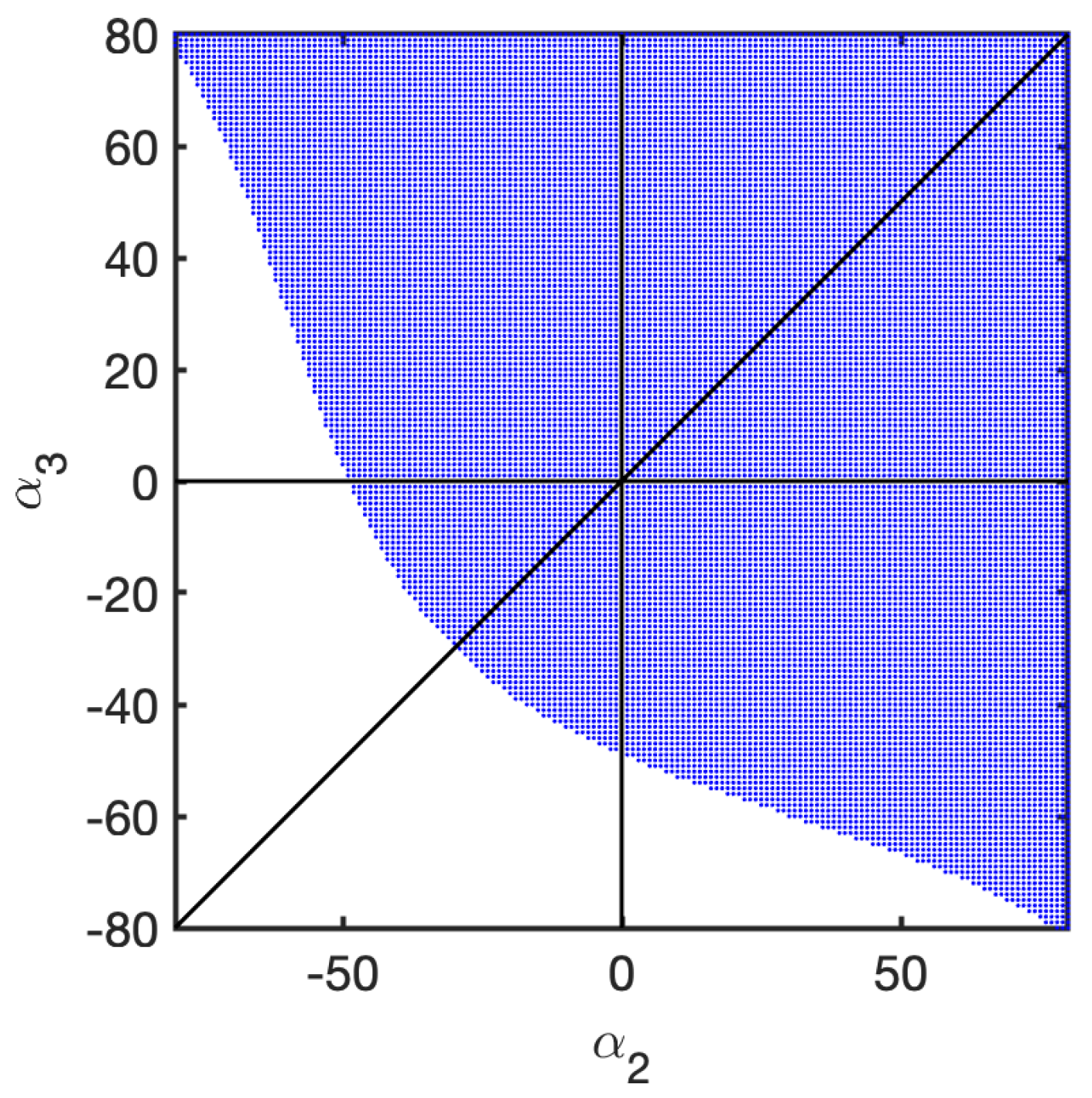

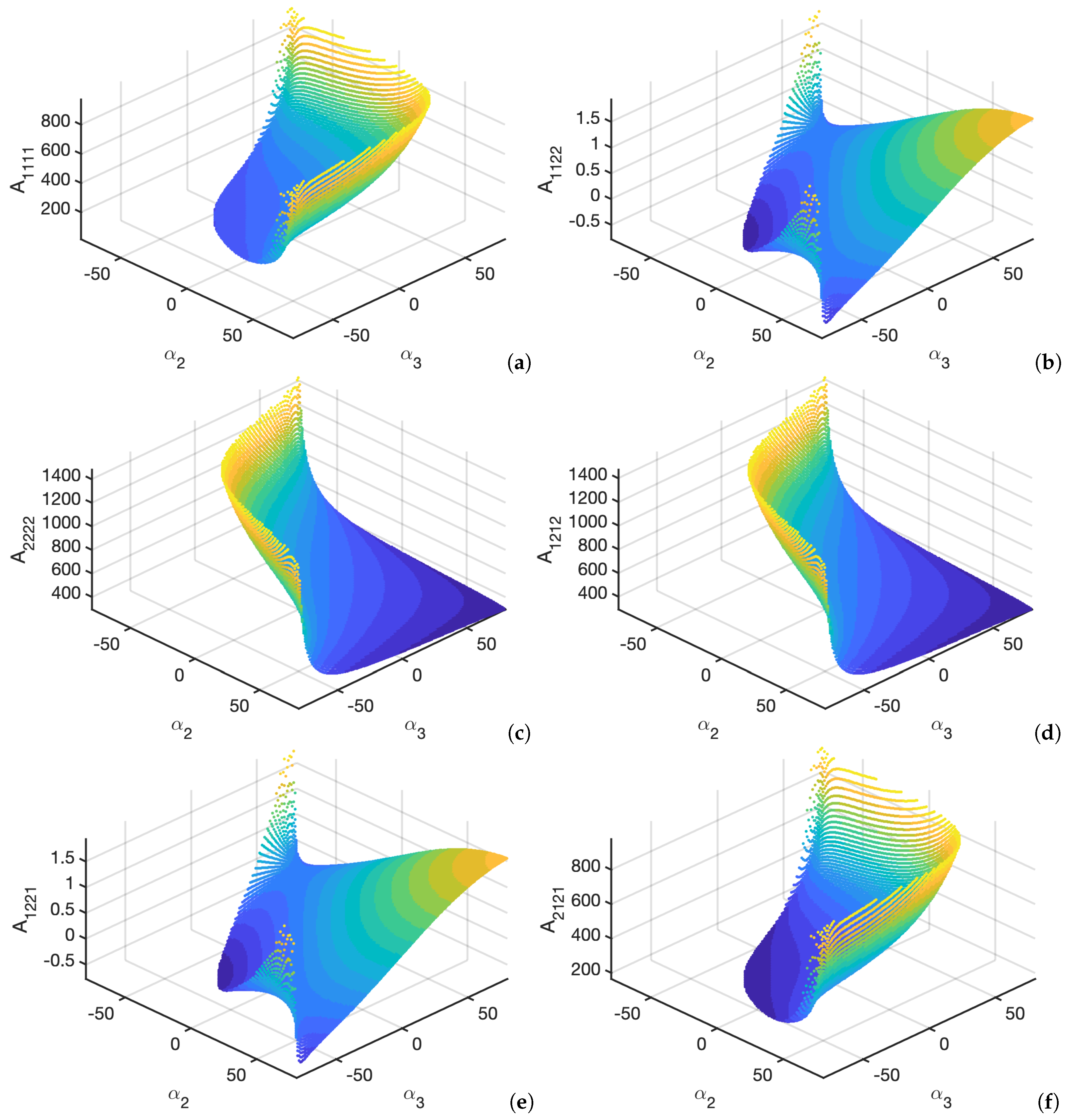
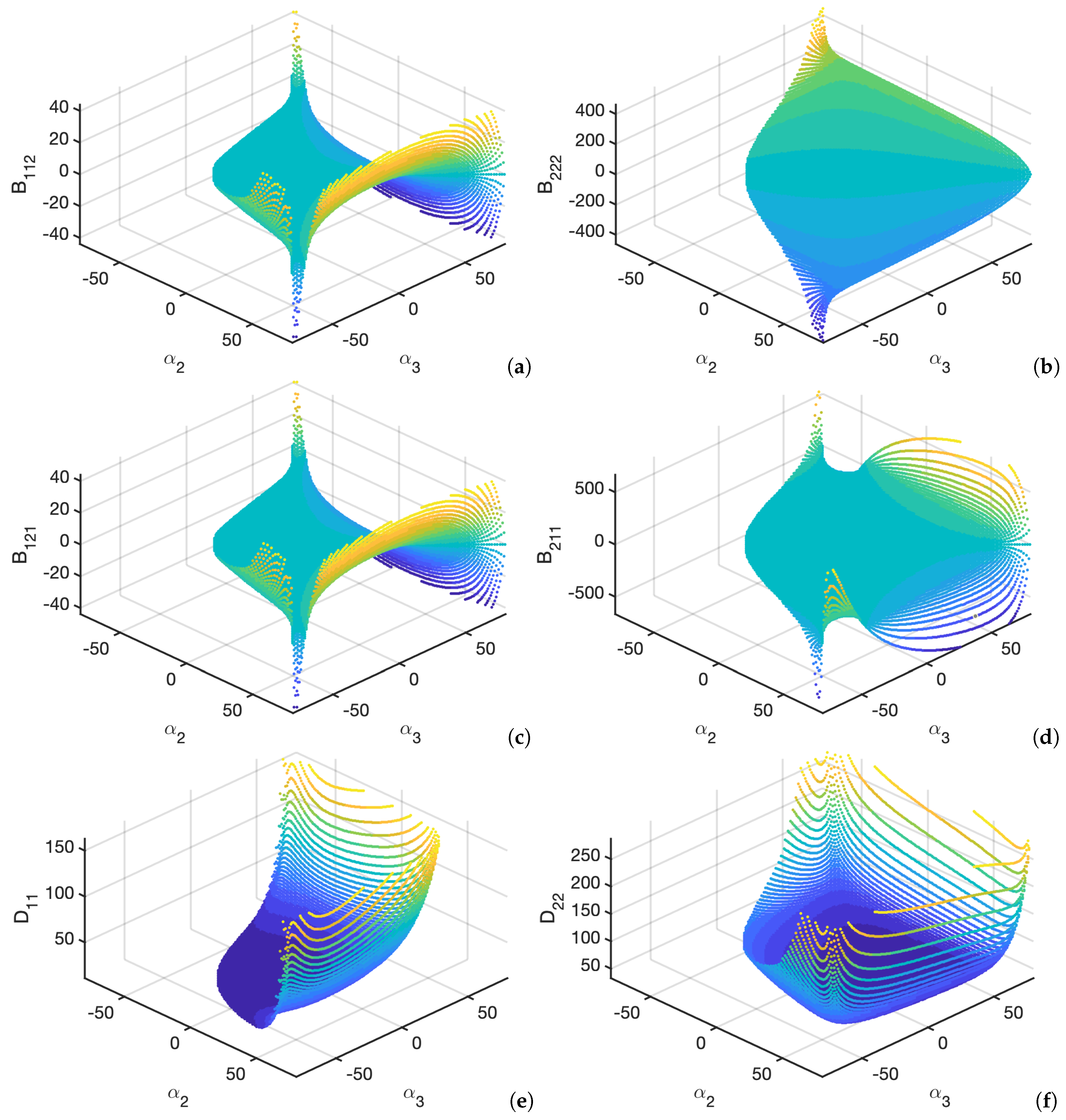
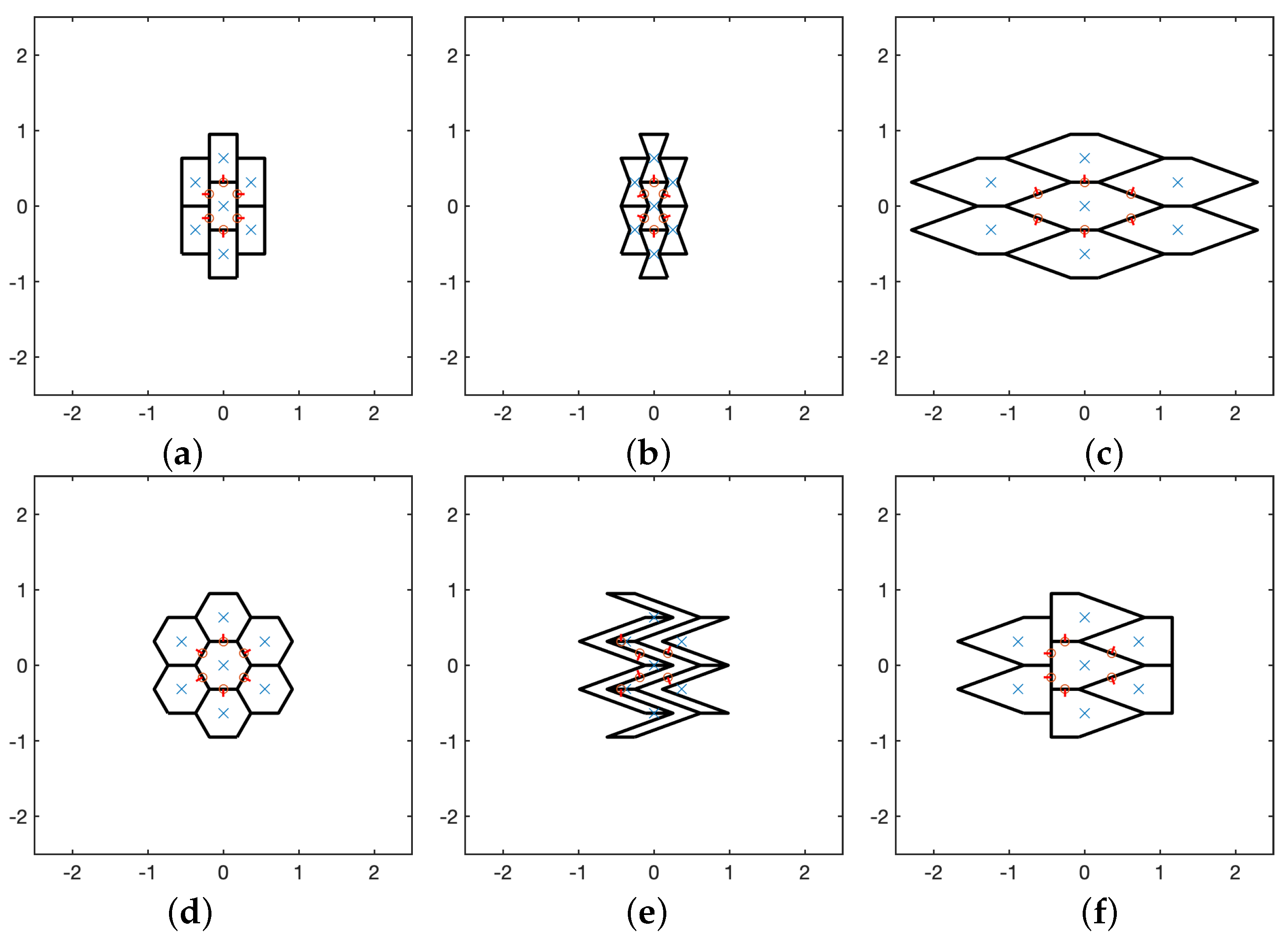
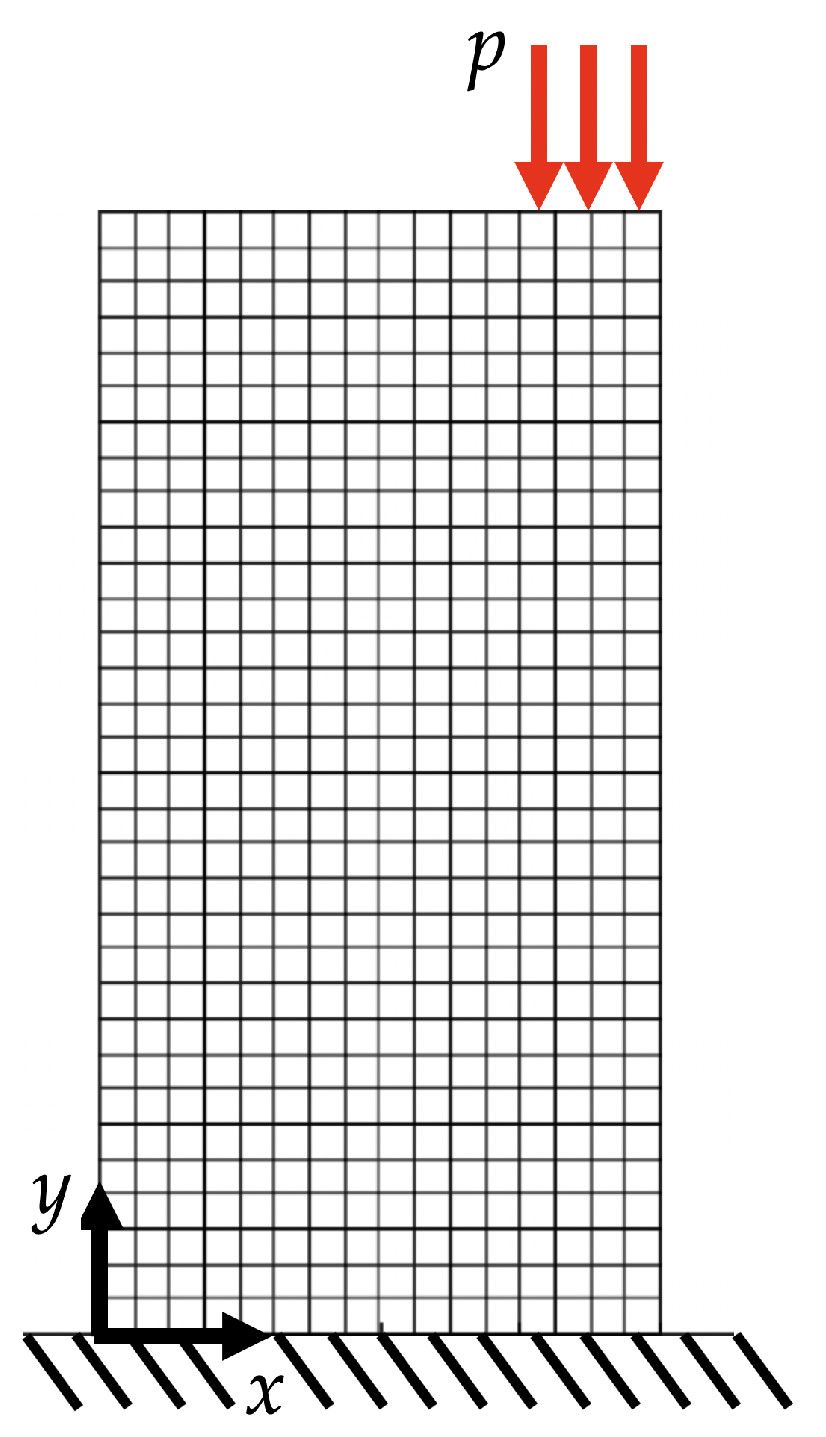

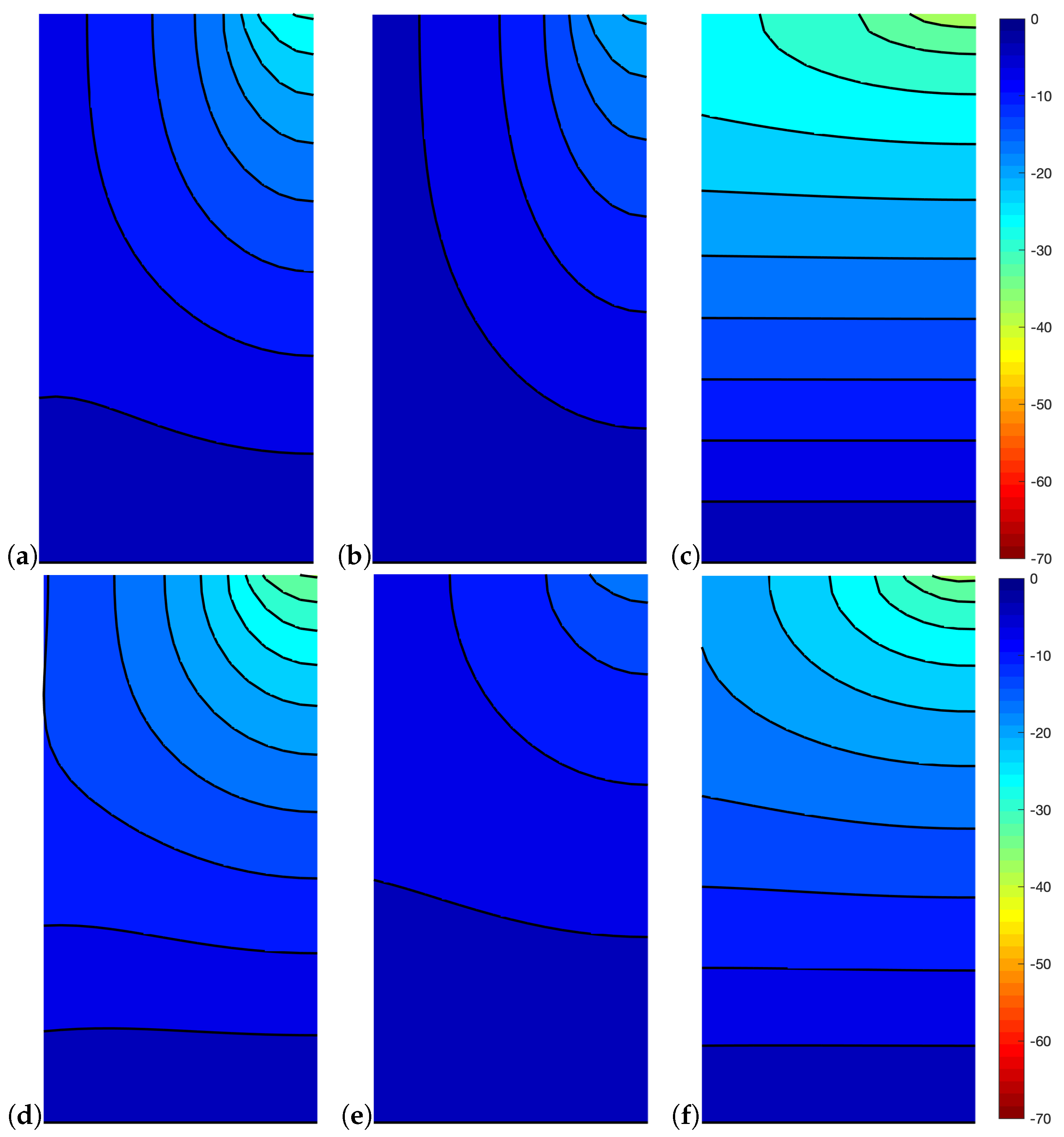
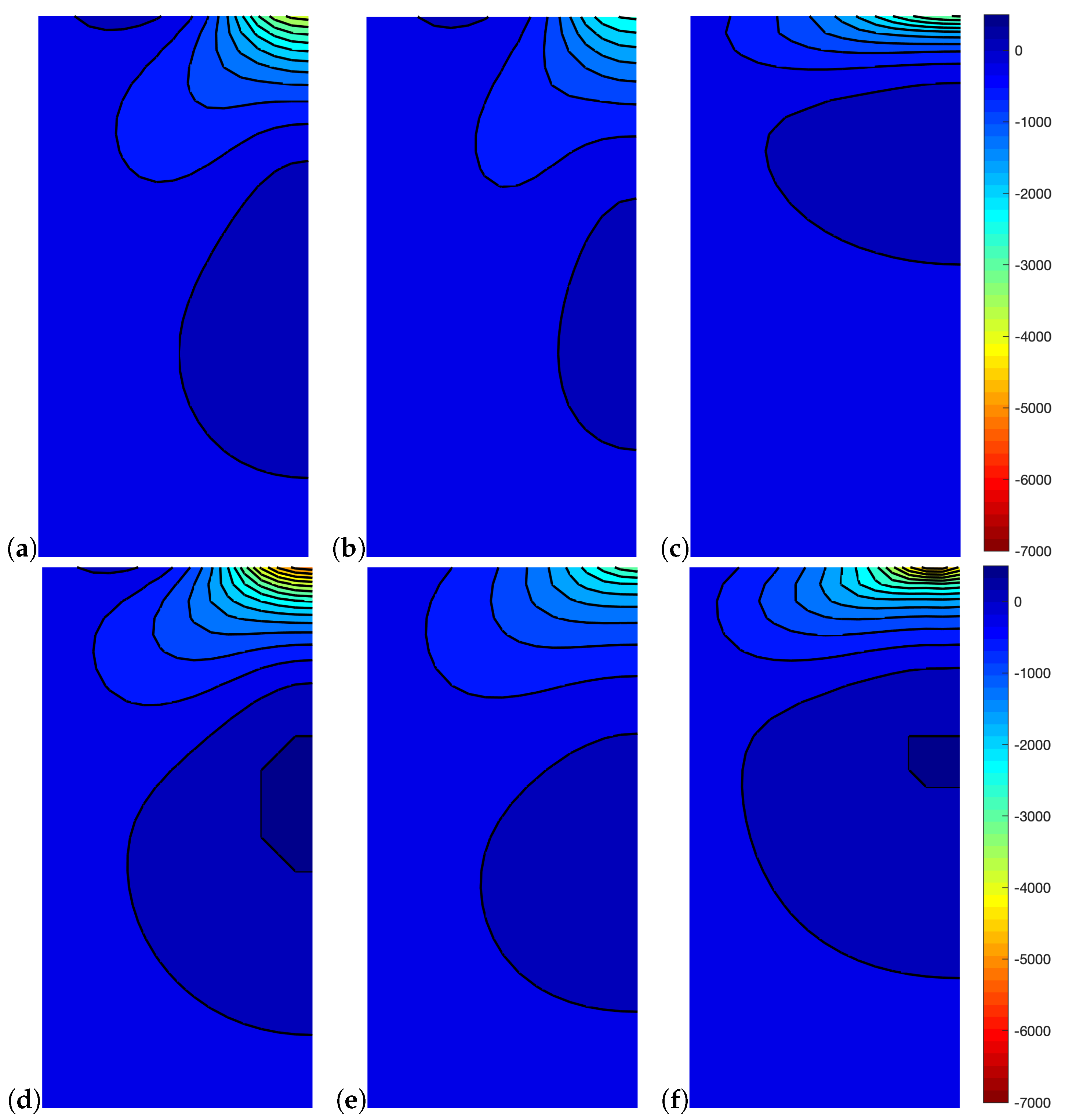


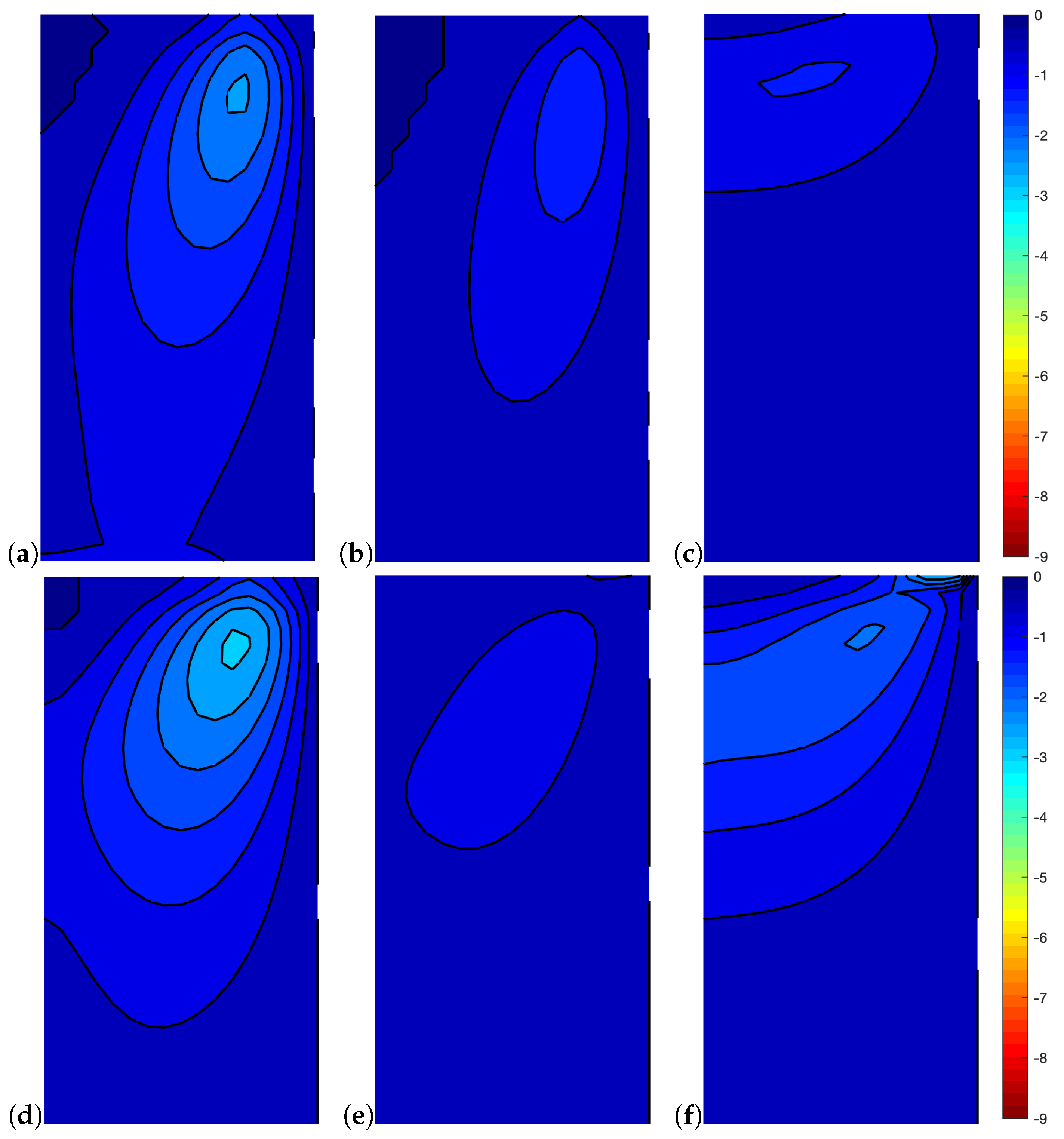
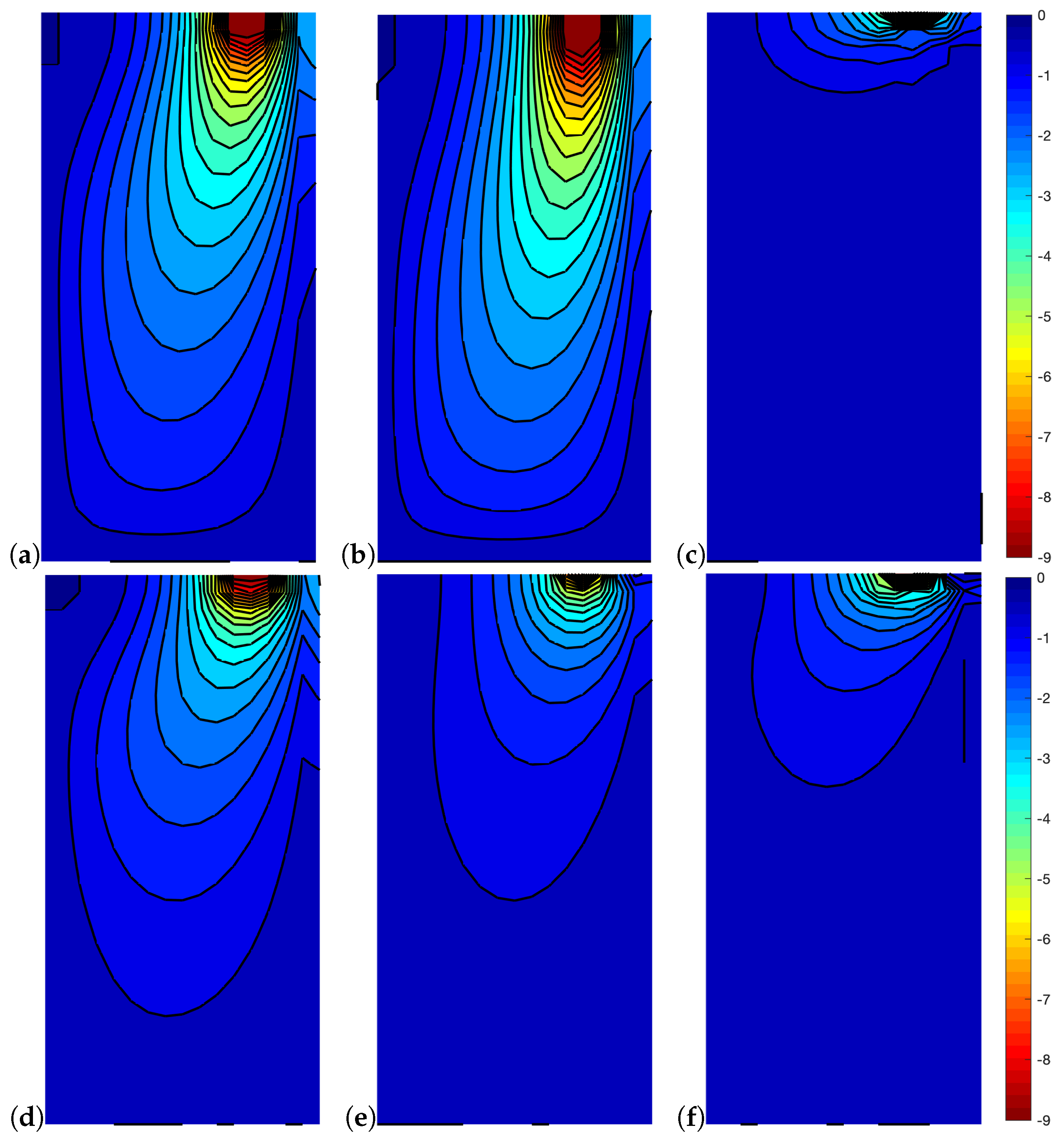
| Rect | Hour | Diam | Reg | Skew | Tip | |
|---|---|---|---|---|---|---|
| 287.3 | 209.2 | 2823 | 496.88 | 835.37 | 1123 | |
| 0 | −0.5 | 1.4894 | 0.79247 | 0 | 0.6714 | |
| 711.8 | 1059.7 | 333.57 | 496.88 | 1127.3 | 419.94 | |
| 710 | 1056.8 | 331.73 | 495.29 | 1121 | 418.1 | |
| 0 | −0.5 | 1.4894 | 0.79247 | 0 | 0.6714 | |
| 285.5 | 208.2 | 2836.9 | 495.29 | 839.47 | 1124.2 | |
| 0 | 0 | 0 | 0 | 0 | 30.03 | |
| 0 | 0 | 0 | 0 | −216.71 | −88.869 | |
| 0 | 0 | 0 | 0 | 0 | 30.03 | |
| 0 | 0 | 0 | 0 | 0 | −103.94 | |
| 14.4 | 11.9 | 1219.3 | 33.338 | 360.81 | 340.19 | |
| 44.2 | 67.7 | 89.941 | 33.338 | 303.95 | 79.488 |
© 2020 by the authors. Licensee MDPI, Basel, Switzerland. This article is an open access article distributed under the terms and conditions of the Creative Commons Attribution (CC BY) license (http://creativecommons.org/licenses/by/4.0/).
Share and Cite
Fantuzzi, N.; Trovalusci, P.; Luciano, R. Material Symmetries in Homogenized Hexagonal-Shaped Composites as Cosserat Continua. Symmetry 2020, 12, 441. https://doi.org/10.3390/sym12030441
Fantuzzi N, Trovalusci P, Luciano R. Material Symmetries in Homogenized Hexagonal-Shaped Composites as Cosserat Continua. Symmetry. 2020; 12(3):441. https://doi.org/10.3390/sym12030441
Chicago/Turabian StyleFantuzzi, Nicholas, Patrizia Trovalusci, and Raimondo Luciano. 2020. "Material Symmetries in Homogenized Hexagonal-Shaped Composites as Cosserat Continua" Symmetry 12, no. 3: 441. https://doi.org/10.3390/sym12030441
APA StyleFantuzzi, N., Trovalusci, P., & Luciano, R. (2020). Material Symmetries in Homogenized Hexagonal-Shaped Composites as Cosserat Continua. Symmetry, 12(3), 441. https://doi.org/10.3390/sym12030441






